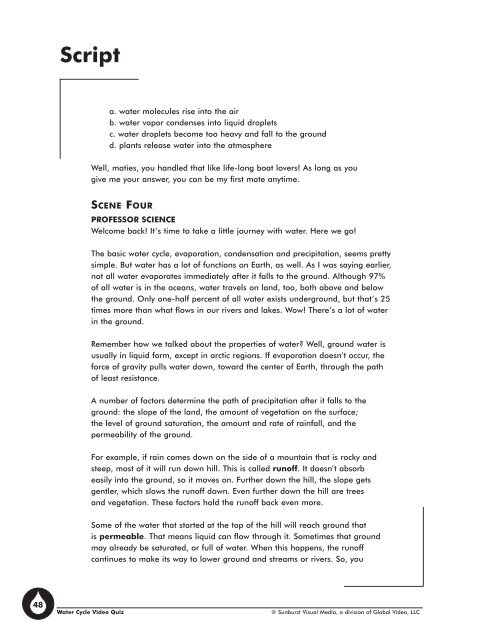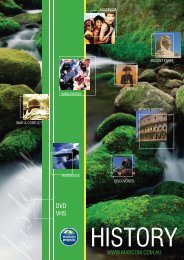Water Cycle - Marcom Projects
Water Cycle - Marcom Projects
Water Cycle - Marcom Projects
You also want an ePaper? Increase the reach of your titles
YUMPU automatically turns print PDFs into web optimized ePapers that Google loves.
48<br />
Script<br />
a. water molecules rise into the air<br />
b. water vapor condenses into liquid droplets<br />
c. water droplets become too heavy and fall to the ground<br />
d. plants release water into the atmosphere<br />
Well, maties, you handled that like life-long boat lovers! As long as you<br />
give me your answer, you can be my first mate anytime.<br />
SCENE FOUR<br />
PROFESSOR SCIENCE<br />
Welcome back! It’s time to take a little journey with water. Here we go!<br />
The basic water cycle, evaporation, condensation and precipitation, seems pretty<br />
simple. But water has a lot of functions on Earth, as well. As I was saying earlier,<br />
not all water evaporates immediately after it falls to the ground. Although 97%<br />
of all water is in the oceans, water travels on land, too, both above and below<br />
the ground. Only one-half percent of all water exists underground, but that’s 25<br />
times more than what flows in our rivers and lakes. Wow! There’s a lot of water<br />
in the ground.<br />
Remember how we talked about the properties of water? Well, ground water is<br />
usually in liquid form, except in arctic regions. If evaporation doesn’t occur, the<br />
force of gravity pulls water down, toward the center of Earth, through the path<br />
of least resistance.<br />
A number of factors determine the path of precipitation after it falls to the<br />
ground: the slope of the land, the amount of vegetation on the surface;<br />
the level of ground saturation, the amount and rate of rainfall, and the<br />
permeability of the ground.<br />
For example, if rain comes down on the side of a mountain that is rocky and<br />
steep, most of it will run down hill. This is called runoff. It doesn’t absorb<br />
easily into the ground, so it moves on. Further down the hill, the slope gets<br />
gentler, which slows the runoff down. Even further down the hill are trees<br />
and vegetation. These factors hold the runoff back even more.<br />
Some of the water that started at the top of the hill will reach ground that<br />
is permeable. That means liquid can flow through it. Sometimes that ground<br />
may already be saturated, or full of water. When this happens, the runoff<br />
continues to make its way to lower ground and streams or rivers. So, you<br />
<strong>Water</strong> <strong>Cycle</strong> Video Quiz © Sunburst Visual Media, a division of Global Video, LLC











